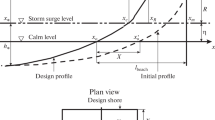Abstract
A new, simple and inexpensive method is proposed to determine the rate of water filtration in the swash zone of lakeshore beaches. Rates of water filtration on a sandy beach were determined by measuring the residue of a tracer injected into several cylinders buried vertically in the sandy layer at various locations from the shoreline to the tip of the swash zone. This methodology enabled the separate estimation of mean infiltration and exfiltration rates. The results obtained for seashore beaches were in accordance with previous data obtained by more conventional methods. The filtration rate results for lakeshore sandy beaches were almost equivalent to seashore sandy beaches, despite a shorter swash length. This paper indicates that this is caused by a larger grain size and shorter wave period. This method presents an easy approach to determine rates of water filtration in sandy beaches and is expected to further promote studies in this field.






Similar content being viewed by others
References
Atherton RJ, Baird AJ, Wiggs GFS (2001) Inter-tidal dynamics of surface moisture content on a meso-tidal beach. J Costal Res 17:482–489
Baird AJ, Horn DP (1996) Monitoring and modeling ground water behavior in sandy beaches. J Coastal Res 12:630–640
Brown AC, McLachlan A (1990) General features of different beach types. In: Ecology of sandy shores. Elsevier, Amsterdam
Hamada A, Tonooka T, Iwasaki J (1996) Changes in water quality via the metabolic process while penetrating a sandy shore in a shallow, eutrophic lake. Jpn J Limnol 57:173–177
Heiss JW, Puleo JA, Ullman WJ, Michel HA (2015) Coupled surface–subsurface hydrologic measurements reveal infiltration, recharge, and discharge dynamics across the swash zone of a sandy beach. Water Resour Res 51:8834–8853
Henderson RD, Day Lewis FD, Harvey CF (2009) Investigation of aquifer-estuary interaction using wavelet analysis of fiber-optic temperature data. Geophys Res Lett 36:L.06403. doi:10.1029/2008.GL06926
Hogue MA, Asano T (2007) Numerical study on wave–induced filtration flow across the beach face and its effects on swash zone sediment transport. Ocean Eng 34:2033–2044
Horn DP (1993) Sediment dynamics on a microtidal beach. J Coastal Res 9:189–208
Horn DP (2002) Beach ground water dynamics. Geomorphology 48:121–146
McLachlan A (1979) Volumes of seawater through Eastern Cape sandy beaches. South Afr J Sci 75:75–79
McLachlan A (1982) A model for the estimation of water filtration and nutrient regeneration by exposed sandy beaches. Mar Environ Res 6:37–47
McLachlan A (1988) Dynamics of exposed beach/dune coast in Algoa, Bay S.E Africa. J Coastal Res Spec Issue 3:91–95
McLachlan A (1989) Water filtration by dissipative beaches. Limnol Oceanogr 34:774–780
McLachlan A, McGwynne LE (1986) Do sandy beaches accumulate nitrogen? Marine Ecol. Prog Ser 34:191–195
McLachlan A, Eliot IG, Clarke DJ (1985) Water filtration through reflective microtidal beaches and shallow sublittoral sands and its implications for an inshore ecosystem in Western Australia. Estuar Coastal Shelf Sci 21:91–104
Nakamura K, Tockner K, Amano K (2006) River and wetland restoration: lesson from Japan. Bioscience 56:419–429
Riedl RJ (1971) How much seawater passes through sandy beaches? Hydrobiol 56:923–946
Riedl RJ, Machan R (1972) Hydrodynamic patterns in lotic intertidal sands and their bioclimatological implications. Mar Biol 13:179–209
Riedl RJ, Huang N, Machan R (1972) The subtidal pump: a mechanism of interstitial water exchange by wave action. Mar Biol 13:210–221
Turner II (1993) Total water content of sandy beaches. J Coast Res Spec Issue 15:11–26
Turner II, Masselink G (1998) Swash infiltration, exfiltration and sediment transport. J Geophys Res 103:30816–30824
Acknowledgements
The authors would like to thank Dr. Masayuki Takahashi, and Dr. Michio Gomyou for their comments and suggestions during the course of this study. The authors wish to thank Dr. Arisuke Suda for providing information on this field. The authors would also like to thank the researchers of Egona for their cooperation.
Author information
Authors and Affiliations
Corresponding author
Additional information
Handling Editor: Richard Sheibley.
Rights and permissions
About this article
Cite this article
Hamada, A., Nakamura, K. & Sasaki, K. Simple estimate of filtration rates on a sandy beach. Limnology 19, 69–80 (2018). https://doi.org/10.1007/s10201-017-0519-x
Received:
Accepted:
Published:
Issue Date:
DOI: https://doi.org/10.1007/s10201-017-0519-x




